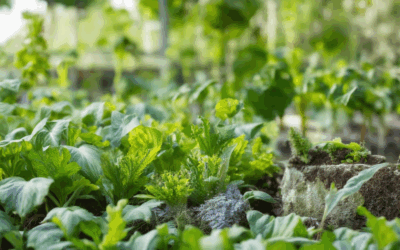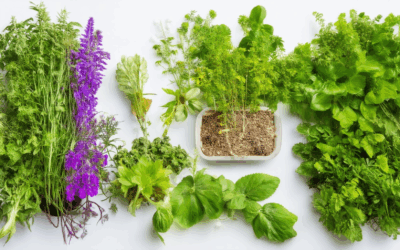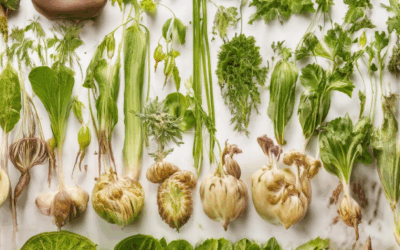Preserving heirloom plants is a cornerstone of sustainable agriculture, offering a bridge between our past and future. These unique varieties, often passed down through generations, represent a wealth of biodiversity and cultural heritage. As the demand for sustainable practices grows, the importance of heirloom plant preservation has never been more evident. By employing effective techniques, we can safeguard these invaluable plants for future generations, ensuring that they continue to thrive and contribute to a resilient agricultural landscape. From traditional methods to innovative approaches, this article explores the best practices for preserving heirloom plants, highlighting their significance and the varied strategies needed to protect them for years to come.
Key Takeaways
– Preserve Genetic Diversity with Seed Saving: Harvest seeds from mature plants and store them in airtight containers for long-term preservation.
– Utilize Rootstocks for Propagation: Regenerate new plants from rootstocks, ideal for varieties like potatoes and carrots.
– Propagate Heirlooms Through Cuttings: Use stem or leaf cuttings to grow new plants, suitable for many heirloom varieties.
– Practice Division for Clonal Preservation: Divide clumps of perennials like rhubarb to maintain genetic integrity.
– Enhance Soil Health with Composting: Improve plant vitality and seed germination by incorporating compost into your garden.
By implementing these techniques, you can effectively preserve heirloom plants and safeguard valuable genetic diversity for future generations.
Effective Methods for Preserving Heirloom Plants
Preserving heirloom plants is a vital step in maintaining biodiversity and ensuring sustainable growth for future generations. Here’s a comprehensive guide to effectively preserving these valuable plants:
- Storage Techniques:
- Store seeds in airtight containers such as glass jars or plastic containers with lids.
- Add silica gel packets to absorb moisture and prevent mold growth.
- Keep storage areas cool, ideally between 35-41°F, to maintain seed viability.
- Propagation Methods:
- Propagate heirloom plants through cuttings to retain genetic integrity.
- Take stem cuttings during the fall or spring season for optimal growth.
- Use a rooting hormone to encourage successful root development.
- Transplant cuttings in well-draining soil and provide adequate sunlight.
- Documentation Practices:
- Maintain a detailed logbook recording each plant’s variety, source, and growing conditions.
- Document successes and challenges to share knowledge with future growers.
- Community and Conservation:
- Join local seed swapping groups or online forums to share and exchange heirloom seeds.
- Consider contributing to seed banks or conservation organizations dedicated to heirloom preservation.
- Testing Viability:
- Test seed viability by attempting germination in controlled conditions.
- If seeds fail to germinate, discard them to avoid wasting resources.
- Sustainable Practices:
- Practice crop rotation and organic farming methods to maintain soil health.
- Share knowledge and resources with fellow gardeners to promote heirloom preservation.
By implementing these strategies, you can play a crucial role in safeguarding heirloom plants for future generations. Remember to always prioritize proper storage, propagation, and documentation to ensure their continued growth and availability.
Best Techniques for Preserving Heirloom Plants
Preserving heirloom plants for future generations is a vital step in maintaining biodiversity and cultural heritage. Here are proven techniques to ensure these plants thrive:
- Seed Saving : Collect seeds during peak production, ensuring they’re dry and stored properly. For optimal germination, consider using Old Seed’s seed-saving guides .
- Cutting Propagation : Take healthy stems or roots and plant them in well-draining soil. This method works well for many heirloom varieties, as mentioned in our propagation resources .
- Root Division : Divide root systems carefully to create new plants. This technique is particularly effective for perennials, as detailed in our growing guides .
These methods ensure heirloom plants remain available for future generations, preserving their unique traits and genetic diversity.
Best Methods for Preserving Heirloom Plants
Preserving heirloom plants is essential for maintaining genetic diversity and ensuring future generations can enjoy unique varieties. Here are proven methods to keep your cherished plants thriving:
1. Seed Saving
Seed saving is a traditional yet effective method for preserving heirloom plants. Proper seed collection involves:
- Harvesting at the Right Time: Collect seeds when the plant naturally ripens, ensuring viability.
- Cleaning and Drying: Remove impurities and dry seeds thoroughly to prevent mold.
- Storing Properly: Keep seeds in an airtight container in a cool, dark place for long-term storage.
2. Root Division
Root division allows you to propagate heirloom plants by dividing root systems. Follow these steps:
- Preparing the Plant: Use a sharp knife to divide roots into smaller segments.
- Planting New Roots: Replant divided roots in rich soil and water regularly until established.
3. Cuttings
Propagation through cuttings is a quick method for preserving heirlooms. Here’s how:
- Taking Cuttings: Use healthy stems or leaves for cuttings and place in damp soil.
- Maintaining Moisture: Keep cuttings moist until they develop roots and new growth.
4. Grafting
Grafting combines two plants to preserve heirloom genetics. Follow these steps:
- Preparing Scions and Stock: Use healthy branches from the desired plant and a compatible stock.
- Joining Techniques: Wrap scions around the stock and secure them, allowing healing time.
5. Using Succession Farming
Succession farming helps maintain soil health and crop rotation for heirlooms. Practice:
- Planned Rotation: Replace heirlooms with companion plants during fallow periods.
- Sustainable Practices: Use organic matter and avoid synthetic fertilizers to maintain soil fertility.
6. Sharing and Collaborating
Community efforts play a vital role in preserving heirlooms. Consider:
- Local Seed Libraries: Access diverse seed varieties and share your own.
- Joining Gardening Groups: Connect with others who share a passion for heirloom preservation.
Tools and Resources
Equip yourself with the right tools for successful preservation. Essential items include:
- High-Quality Seeds: Source heirloom seeds from reputable suppliers like Old Seed .
- Organic Fertilizers: Opt for natural options to support plant health.
- Composting Systems: Enhance soil health and promote sustainable practices.
By employing these methods, you can effectively preserve heirloom plants and contribute to biodiversity conservation. Explore more resources and techniques on Old Seed to enhance your gardening journey.
Best Ways to Preserve Heirloom Plants
Preserving heirloom plants is essential for maintaining genetic diversity and ensuring future generations have access to unique and valuable crop varieties. Here are some effective methods to preserve these special plants:
- 1. Save Seeds
- Harvest seeds when the plant is mature but before it self-seeds naturally.
- Store seeds in a cool, dry place with low humidity, such as airtight containers or seed boxes.
- Label the seeds with details like the plant variety and the year saved.
- Consider storing seeds in a seed bank for long-term preservation.
- 2. Use Rootstocks
- Rootstocks are underground stems that can regenerate into a new plant.
- Divide roots carefully and replant them in the soil to grow new plants.
- This method works well for plants like potatoes, carrots, and sweet potatoes.
- 3. Propagate Through Cuttings
- Take cuttings from healthy, mature stems or branches.
- Use different methods like hardwood, softwood, or semi-softwood cuttings depending on the plant type.
- Mist the cuttings and place them in a well-draining medium until they root.
- Rooted cuttings can be transplanted into the garden or pots for growth.
- 4. Practice Division
- Divide clumps of perennials like rhubarb, daylilies, or bamboo.
- Each division can grow into a new plant, ensuring the original variety is preserved.
- 5. Utilize Composting
- Compost can enrich the soil and promote healthy growth of heirloom plants.
- Apply compost around the base of the plant to improve fertility and structure.
- This practice also helps with seed germination and plant health.
Additional Tips for Success:
- Choose heirloom plants that are suited to your climate and growing conditions.
- Document your preservation efforts, including dates and methods used.
- Engage with local gardening communities or seed swap groups for support and resources.
- Stay informed about the latest techniques in heirloom plant preservation through reliable sources and workshops.
By implementing these methods, you can successfully preserve heirloom plants and contribute to a sustainable future for gardening and agriculture.
What Are the Best Techniques for Preserving Heirloom Plants?
Preserving heirloom plants involves careful techniques to ensure their survival for future generations. Here are some proven methods:
- Seed Saving: Collect seeds from mature plants in late summer or early fall. Store them in a cool, dry place like airtight containers or seed boxes. Label them with variety names and dates.
- Propagation Methods: Use methods like root division or cuttings to propagate heirloom plants. Root division works well for certain species, while stem cuttings can be rooted in soil or water.
- Cold Stratification: Immerse seeds in moist sand or paper towels and refrigerate for 4-6 weeks to simulate winter conditions, boosting germination rates.
- Companion Planting: Grow companion plants like marigolds or nasturtiums to deter pests and enhance pollination, benefiting your heirloom crops.
- Storage Tips: Keep seeds and bulbs in a dark, stable environment. For bulbs, store them in soil in a cool, dry location until planting time next year.
For more detailed guides and resources, visit Heirloom Gardening and Seedsavers .
Effective Techniques for Preserving Heirloom Plants
Heirloom plants are precious genetic treasures, and preserving them requires thoughtful care and knowledge. Here are proven strategies to ensure their survival and continued growth:
1. Proper Storage Methods
- Root Cellars : Ideal for root crops like carrots and beets, these cool environments mimic natural caves and preserve roots through the winter.
- Cold Frames : Protect tender plants like tomatoes and peppers during frosty nights, allowing them to thrive in controlled conditions.
- Seed Banks : Store seeds in airtight containers in a cool, dark place to maintain viability for future planting seasons.
2. Seed Saving Techniques
- Dry Seeds : Harvest seeds when they mature and dry them thoroughly to prevent germination inhibitors from forming.
- Cold Stratification : Immerse seeds in moisture and refrigerate for a few weeks to simulate natural winter conditions, enhancing germination rates.
- Seed Swap Networks : Join online communities or local groups to share and trade seeds, ensuring diverse gene pools for future generations.
3. Choosing the Right Varieties
- Opt for open-pollinated or heirloom varieties known for their hardiness and adaptability to specific climates.
- Seek recommendations from experienced gardeners or agricultural resources to select plants suited for your region.
4. Avoid Common Mistakes
- Overcrowding plants can stress them, leading to disease. Maintain adequate space for healthy growth.
- Untreated seeds can lose viability over time. Use proper storage methods to extend their shelf life.
By implementing these techniques, you can successfully preserve heirloom plants and contribute to the conservation of valuable genetic diversity. Explore more resources on Old Seed for comprehensive guides and tools tailored to heirloom gardening enthusiasts.








0 Comments